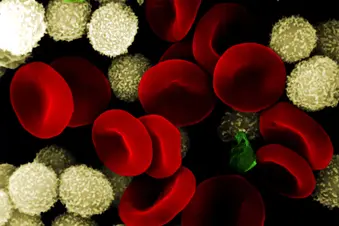
When you have asthma, the airways in your lungs get narrow and swollen. They also make too much mucus. This sets off spasms in the tubes that let air in and out of your lungs (bronchial tubes). The spasms make it hard to breathe. You may also wheeze and cough. It’s an ongoing, lifelong condition.
There are several different types of asthma. Each type has different triggers. These can be things such as exercising too hard or stuff in the air like smoke or pollen.
One type is a serious kind called eosinophilic asthma. It’s harder to control with typical medications. Science links it to higher levels of white blood cells called eosinophils. These cells are part of your immune system. They help to kill things that don’t belong in your body such as harmful bacteria. They also control inflammation.
Researchers have found that the more eosinophils in your blood, the more likely you are to have a serious asthma attack. But they aren’t sure what causes their numbers to go up. They have learned that eosinophilic asthma is different from other forms of the condition in a few ways:
Who It Impacts
Asthma often starts when you’re a child, but the eosinophilic type most often appears in adults around middle age.
Even though this kind of asthma does happen in children and older adults, it’s more likely to first come on when you’re between the ages of 35 and 50. It’s not clear how many people it affects. But researchers think that less than 10% of people with asthma have a type as serious as eosinophilic asthma. They’ve also found that men and women get this type in equal numbers.
Triggers and Symptoms
Many times, an allergy to things like pollen or pet dander can trigger asthma symptoms. But people with eosinophilic asthma don’t tend to have these allergies. What sets this type apart from other forms of the condition is a higher number of eosinophils in your blood, lung tissue, and coughed-up mucus (sputum).
Symptoms like wheezing, coughing, and shortness of breath happen in all types of asthma. But this kind affects your entire respiratory system. This means that you’ll likely get a lot of sinus infections. You may also get nasal polyps, noncancerous growths in the nasal passages or sinuses. You may also notice that the lining in your nose (mucous membrane) gets swollen and irritated.
Your symptoms may not look and feel like those of what you think of as typical asthma. They could seem more like chronic pulmonary obstructive disorder (COPD). This is a lung disease that causes long-term breathing problems and poor airflow. Sometimes doctors diagnose eosinophilic asthma as COPD by mistake.
Diagnosis
To figure out if you have asthma, your doctor will give you a physical exam. They’ll ask you about your symptoms and other health problems. You may also have to take lung function (pulmonary) tests. These will tell you how much air you can breathe out and how quickly you can do it.
To diagnose eosinophilic asthma, you may need some extra tests to look for eosinophils:
- Blood test. A doctor or nurse will draw your blood to measure the number of eosinophils in it.
- Sputum sample. You’ll cough up a sample of mucus. Your doctor will then examine it under a microscope.
- Bronchial biopsy. This test is less common. Your doctor will put a tool called a bronchoscope into your nose or mouth. They’ll use it to get several small tissue samples from your lungs (biopsy). They’ll analyze these for eosinophils. You’ll need to drugs to stop pain (anesthesia). You may have to stay in the hospital.
Treatment
There are two goals for treatment of this type of asthma: control your breathing and reduce eosinophils. You may feel symptom relief from typical asthma treatments. These include drugs that stop inflammation (corticosteroids) and quick-relief inhalers (bronchodilators).
But these medications don’t always work for people with eosinophilic asthma. Your doctor could also give you a medicine called a biologic. It targets eosinophils and makes your body less able to make them. You’ll take it along with other asthma drugs.
It’s important to diagnose and treat this condition early so you can stop lasting damage to your lungs, such as lung tissue scarring and thickened airway walls. See your doctor once a year to go over your treatment plan and make sure it’s still right for you.
Show Sources
SOURCES:
Mayo Clinic: “Asthma,” “Nasal polyps,” “COPD.”
American Partnership for Eosinophilic Disorders: “Eosinophilic Asthma.”
Cincinnati Children’s: “What is an Eosinophil?”
National Heart, Lung, and Blood Institute: “Asthma.”
Journal of Asthma and Allergy: “Diagnosis and management of eosinophilic asthma: a US perspective.”
Therapeutic Advances in Chronic Disease: “Eosinophilic airway inflammation: role in asthma and chronic obstructive pulmonary disease.”
American Lung Association: “When to See Your Doctor.”